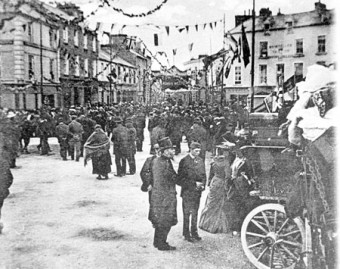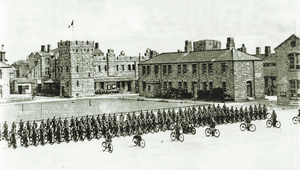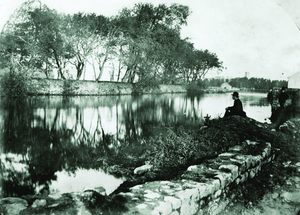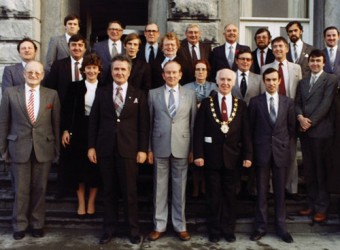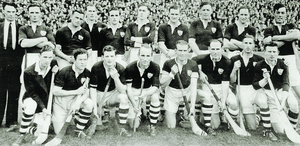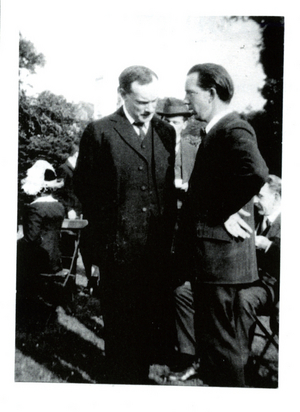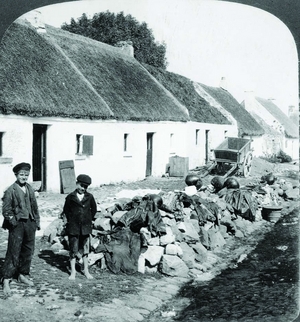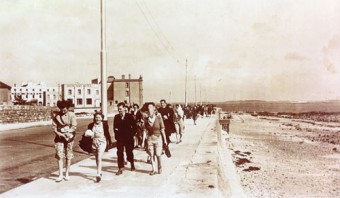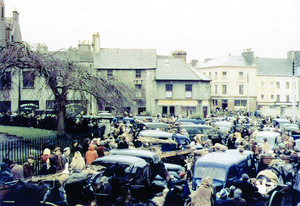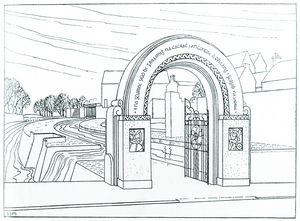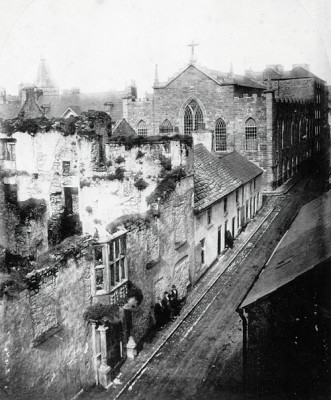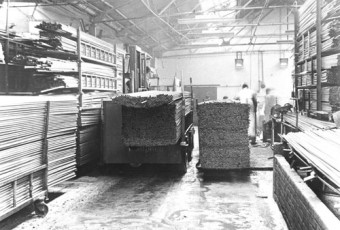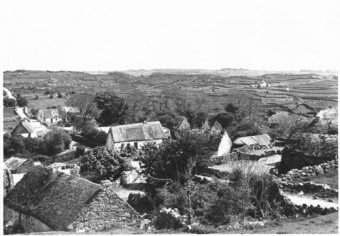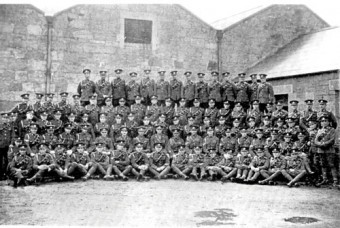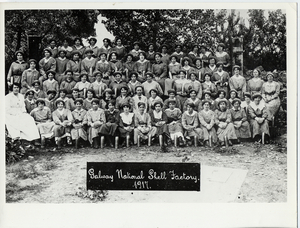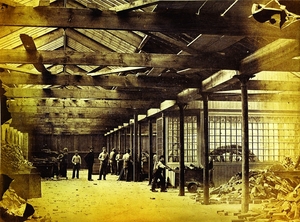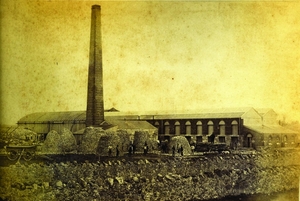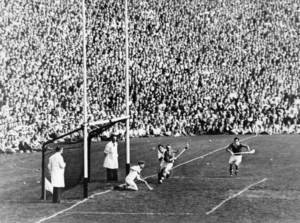Edward VII in Galway, 1903
Thu, Feb 20, 2014
At the beginning of the last century, the Prince of Wales would have been one of the most famous personalities known to most Irish people. He had been to County Galway on a few occasions hunting, but when it was announced he was going to make an official visit, it aroused very mixed emotions. There were a lot of objections locally, led by an umbrella group known as the National Council. They disrupted preparatory meetings by shouting and heckling. Nationalists were not impressed either and other objectors included Edward Martyn, WB Yeats, Maud Gonne, and George Moore.
Read more ...Renmore Barracks, a brief history
Thu, Feb 13, 2014
Because of its strategic location, Galway was always an important centre for the military. The original fort in Renmore was known as St Augustine’s Fort and featured prominently in the 1641 rebellion, after which it was abandoned, the purpose for which it had been built having been accomplished.
Read more ...The view from the distillery, c1885
Thu, Feb 06, 2014
Towards the end of last year, we featured a series of articles on the building that is now occupied by the students’ bar in NUIG. The building started as a jute bag factory, then was converted to a bonded warehouse for Persse’s Distillery, later became the National Shell factory during World War I, was occupied by the 17th Lancers and the 6th Dragoon Guards, before being converted into the ammunitions factory known as IMI.
Read more ...Galway’s Quincentennial, 1984
Thu, Jan 30, 2014
On January 1 1984, President Patrick Hillery officially launched the Quincentennial, a year long celebration of 500 years of civic independence unique in western Europe. In 1484, a number of Galwegian merchants persuaded King Richard III to grant the city a charter which made the town a mayoral city. In the same year Pope Innocent VIII granted them the power to nominate their own warden and priests.
Read more ...Tommy Moroney and the Galway hurlers
Thu, Jan 23, 2014
For many years the Galway hurling team qualified automatically for the All Ireland semi-finals as Connacht champions. The problem for them was the semi-final was always their first championship game, whereas the team they were playing always had a few good tough games under their belt. As a result, we only had the one championship game in the season and rarely got to the final.
Read more ...An Irish Republic: The first blow is struck
Thu, Jan 23, 2014
One hundred years ago, a series of dramatic events caused turmoil in Ireland, and made rebellion practically inevitable.
Read more ...Humble but happy homes
Thu, Jan 16, 2014
The library of Congress in Washington kindly lent us this photograph (originally one half of a stereo photograph), which was taken in 1903. It shows “The humble but happy homes of the Claddagh fisher folk, Galway”.
Read more ...Salthill Prom in the fifties
Thu, Jan 09, 2014
The Prom has been much in the news in the last few days. In Victorian times, our ancestors used to advertise the Promenade as a place unrivalled in the country, where a person could take the healthy invigorating air like nowhere else. In those days, it was just a narrow crooked roadway, very rough and untarred, and it extended from Palmer’s Rock to Blackrock. There were no shelters or flower beds, indeed there was hardly any beach, just rocks and shingle and seaweed. The cleaning up process started when breakwaters and piers were built, so there is a lot more beach now than there was 60 years ago. There were no large boulders to strengthen the Promenade, and flooding from the tide was far more regular than it is today – with the experience of this past couple of weeks excepted.
Read more ...Galway market in the mid-twentieth century
Thu, Jan 02, 2014
“Let not the visitor miss the joyful chaos of Galway’s week-end purchasing. Saturday is not a day of speed. Petrol must give way to horsepower and donkey-power, and cattle that like to investigate both sides of a road. Proud, glittering models of fame crawl humiliatingly in face of a stream of vehicles of astonishing build and variety, rumbling in from Connemara. Carts piled with sacks of oats, potatoes, flour; others with crates of wondering calves and bewildered fowls. It is the great day – not necessarily a happy one – of small brown donkeys further dwarfed by huge wheels and the garden produce heaped above them. Around you in the streets, or about the food market in the shadow of the ancient church, you can hear the musical Gaelic speech. Tall, handsome women of Spanish type dark-haired and dignified: island women whose features speak hardiness and force of character: and women of the rock-strewn dazzling region about Carraroe unwittingly bring upon themselves the staring that notabilities endure. The men also receive attention. Of fine physique their faces healthily browned by sea and mountain winds, they attract you so that you wander, fascinated, from group to group. Old men in home spun, with the wide-brimmed Connemara hats, and the younger in tailored suits and coloured felts of fashion are alike in keenness of selling and shrewdness of buying.”
Read more ...The Galway volunteer memorial committee
Fri, Dec 27, 2013
This committee, also known as Coiste Cuimhneacháin Óglach Condae na Gaillimhe, was set up in the late 1940s, and represented all shades of political opinion. Its objective was to erect a memorial gateway to the memory of all the men and women of Galway city and county who suffered for freedom during the years 1916 to 1923. The chairman of the committee was Louis O’Dea and the joint honorary secretaries were Mrs T Dillon and Mr John Hosty.
Read more ...Christmas Day in the Pro-Cathedral, 1842
Thu, Dec 12, 2013
This photograph of Lower Abbeygate Street was taken from the top of a warehouse on the corner of Whitehall c1870. In the foreground you can see the remains of the Browne Mansion, and the original site of the Browne Doorway. Further up the street is the Pro-Cathedral, which was the site of an appalling disaster on Christmas Day, 1842. The following, which appeared in The Dublin Pilot, is a graphic account of what happened.
Read more ...The Conradh na Gaeilge Oireachtas and Ard-Fheis held in the Town Hall 1913
Thu, Dec 05, 2013
Conradh na Gaeilge, also known as the Gaelic League, was founded by Douglas Hyde and Eoin McNeill in July 1893. Their aim was to keep the Irish language alive and preserve the Gaelic elements of Ireland’s culture. It was open to all creeds, was non-political, and accepted women on an equal basis. It used a broad approach, organising classes and competitions in Irish music, dancing, literature, and games. After a sluggish six years in existence, it suddenly morphed into a mass movement.
Read more ...Irish metal industries
Thu, Nov 28, 2013
Over the last few weeks we have been writing about the building on Earl’s Island which began life as a bleach and flax mill in the 1850s. It was then converted into a jute factory, became a bonded warehouse, a factory for making cannon shells during World War I, and was occupied by the 6th Dragoon Guards and the 17th Lancers during the War of Independence. After the British army left, it was vacant for a while before being converted into a factory known as IMI, or Irish Metal Industries.
Read more ...Shantalla village, 1945
Thu, Nov 21, 2013
This remarkable photograph of Shantalla village was taken in 1945 by Pádraic Mac Dubháin and is from the National Museum collection. You will sometimes see the place name written as Shantallow and you will hear it pronounced Shantla by people with Galway accents. It is derived from the Irish ‘Sean Talamh’, old ground, though why Shantalla should be older ground than that which surrounds it is a mystery. Maybe it is because some of the land was not being worked.
Read more ...The 17th Lancers in Earl’s Island
Thu, Nov 14, 2013
When World War I finished and the National Shell Factory on Earl’s Island closed down, the buildings were taken over by the 6th Dragoon Guards who had a reputation for wanton brutality. This was unusual in that most well armed British army units, with few having a role in the intelligence conflict, were rarely attacked during the War of Independence in the west of Ireland. While individual RIC men became defined as ‘good’ or ‘bad’, it was army regiments, rather than individual soldiers, that became so defined.
Read more ...The Galway national shell factory
Thu, Nov 07, 2013
During the First World War, towns and cities throughout Britain and Ireland had factories producing munitions for the battlefield. Galway was not one of these locations and indeed many Galwegians were travelling to the UK to work in these factories. There was a lot of criticism over this and so the members of the Urban Council and some local industrialists began a lobbying campaign to attract such an industry to the city. It would create employment and would be beneficial to the community.
Read more ...Persse’s Bonded Warehouse, Earl’s Island
Thu, Oct 31, 2013
Two weeks ago in this column, we showed some photographs of the Jute Spinning factory in Earl’s Island, and what I thought were large stacks of turf beside the building. An eagle eyed reader has pointed out that these were not sods of turf, they were ‘jute butts’, stems of the jute plant from which the fibres were extracted. They were stacked out in the fresh air because they are easier to work when wet. The fibres that made up the rough jute products were extracted from the top half of the plant.
Read more ...The Galway Jute Spinning Company
Thu, Oct 24, 2013
There seems to have been a few different names on this business but it was known locally as the bag factory. The chairman, Lieutenant Colonel James O’Hara, reported to the Select Committee on Industries Ireland (1884-85) on the company.
Read more ...The Galway jute factory
Thu, Oct 17, 2013
The Galway Vindicator and Connaught Advertiser of December 24 1851 carried an advertisement which read “TO BE LET, for such terms as may be agreed upon, and immediate possession given. EARL’S ISLAND MILL AND BLEACH GREEN. These well-known concerns occupied for so many years by the late Mr Mitchell, Linen Manufacturer, Miller, Bleacher, have always been esteemed to point of situation; preferable to every other site in Galway, but the improvement made by the Board of Works under the inspection of their skilful engineer SU Roberts ... have rendered it superior to any in the Kingdom. The land will be secured against being flooded for any part of the year. The Mill Race has been changed ... the Mill Power amended and is now equal to 40 horse power. The canal between Lough Corrib and the sea leaves the lake at the very point on which the Mill stands. The layby for boats is within 20 yards of it, and the spacious quay with landing crane and every accommodation for shipping goods will adjoin.”
Read more ...‘Up goes that hand again for Galway’
Thu, Oct 03, 2013
Those words were a regular part of Mícheál Ó Hehir’s radio commentary on hurling matches in the 1940s and 1950s when Galway were playing. The hand he was talking about belonged to Sean Duggan, who was arguably the greatest goalkeeper ever in the history of the game.
Read more ...